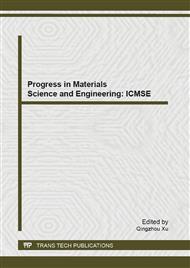p.567
p.574
p.579
p.584
p.588
p.594
p.599
p.605
p.610
Effect of Conductive Silicone Rubber Fillers on Piezoresistive Properties
Abstract:
Through the preparation of conductive silicone rubber samples, and the study of its electrical characteristics, this paper expounds the conductive silicone rubber composites relationship between the resistance and applied pressure. It discusses the main influencing factors of the piezoresistive effect. It studies conductive silicone rubber in four different conductive particles as well as the piezoresistive behavior of blending with a variety of fillers. It analyzes conductive silicone rubber samples after adding nanometer material of the piezoresistive properties. The study shows that blending with a variety of appropriate fillers material can improve the linearity of the piezoresistive relationship of the conductive silicon rubber and effectively expand the resistance variable range.
Info:
Periodical:
Pages:
588-593
Citation:
Online since:
October 2013
Authors:
Price:
Сopyright:
© 2013 Trans Tech Publications Ltd. All Rights Reserved
Share:
Citation:


